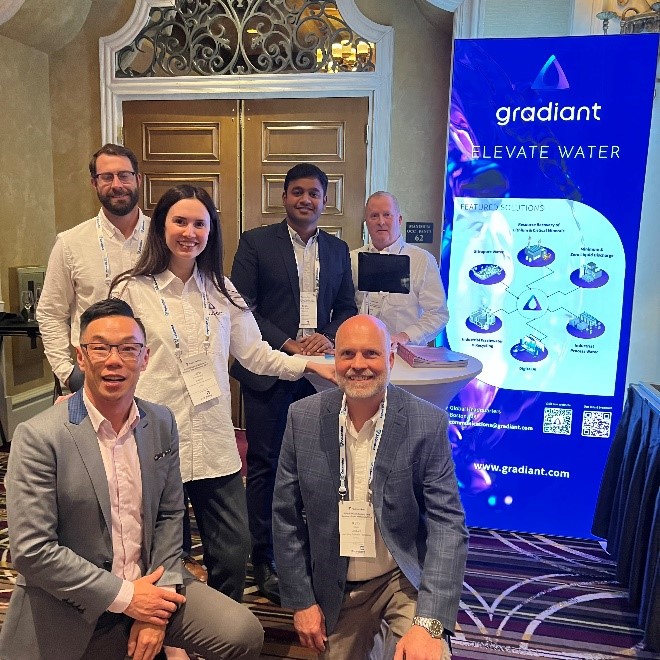The Gradiant team is back – invigorated and fully charged – following the Fastmarkets Lithium Supply and Battery Raw Materials conference held June 20 to 22, 2023 in Las Vegas, Nevada. The event was the largest global forum for lithium and battery raw materials – with end-to-end coverage of the industry, from supply chain risks to direct lithium extraction technologies to the latest battery recycling innovations. About 1,100 people attended this year, up 68% (from 650) of last year’s event. The full agenda is here.

We met our partners across the EV battery supply chain to discuss the global race for lithium. The worldwide supplies of lithium and other key battery minerals will not be enough to meet electric vehicle demand. Automobile manufacturers will need a 20x increase in lithium supply – unachievable when relying on conventional technologies. According to Fastmarkets, there were 45 lithium mines operating in the world last year, with 11 expected to open this year. This pace is far below what’s needed to meet global demand and doesn’t consider the downstream refining and manufacturing.
Our main takeaways from the event:
- Demand and Battery Chemistries. There will be strong demand for lithium-ion batteries in the current nickel-cobalt-manganese (NCM) cathode chemistries. The share of lithium-ion phosphate (LFP) and sodium-ion batteries will grow as technologies improve. New projects are coming online, but not at a rate to keep up with market demand for EVs and Energy Storage Systems (ESS).
- Energy Storage Systems. While the need to supply for the EV market will continue to dominate, batteries for ESS will become more important. ESS reduce the imbalance between energy demand and energy production by capturing and storing the energy produced for later use. Fastmarkets estimates 20% CAGR through 2030 for ESS.
- The US Inflation Reduction Act (IRA). Last year’s introduction of the IRA requires automakers to have at least 50% of the critical minerals used in EV batteries come from North America or US partners by 2024. This creates pressure for manufacturers to build a supply chain in the US, leading to the development of alternative methods for mining and refining.
- Directly Lithium Extraction (DLE) and Sustainability. DLE is becoming an important technology to unlock lithium trapped in underground brine, improve the recovery of conventional methods, and meet the requirements of the IRA to source from the US or its partners. DLE offers sustainability advantages in water use and management and lower environmental risk. Long-term agreements are starting to consider more than price and volume – where environmental permitting and community engagement are becoming critical to a project’s success.
- Battery Recycling. The market is looking to the recycling of lithium-ion batteries as the world’s supply of lithium and battery materials face growing pressure. The industry is nascent as new technologies and recycling processes are being commercially proven. Watch this space.
Lithium has historically been mined from hard rock or evaporated in massive ponds of brine from beneath the Earth’s surface. The latter is a simple but inefficient process, requiring large areas of land, patience to wait 18 months for evaporation, and greater environmental risks.
DLE is an emerging technology where lithium-laden brine is treated directly from the ground in a series of chemical processes and reinjected into the reservoir. DLE avoids the downsides of hard rock mining and evaporation ponds – handling and transport over great distances, long processing times, and environmental risks – to produce battery-grade lithium compounds in a matter of hours. Goldman Sachs has said DLE could do for lithium what fracking did for the oil industry.
Gradiant’s RO Infinity technology enhances the DLE process— reducing time-to-market and environmental footprint. The brine concentration technology enables high levels of lithium recovery in a fraction of the time required by conventional methods while also reducing carbon emissions, energy consumption, and capital costs when compared to thermal-based technologies. The technology integration can be applied to new lithium mineral extraction and production sites, opening opportunities to untapped lithium production regions, as well as existing lithium production operations.
Gradiant’s solutions help the mining industry recover valuable metals and reduce water and carbon footprints. We enable the sustainable production of high-purity lithium and battery materials for EV battery manufacturing and recycling. Beyond lithium, Gradiant technologies are proven commercially in the sustainable production and recovery of other valuable metals, including nickel, cobalt, graphite, and uranium.
Learn more about our work for the mining industry and lithium and resource recovery:
Download our brochure here.
Contact us today to talk to one of our experts: gradiant.com/contact





